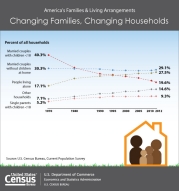For Immediate Release: Tuesday, August 27, 2013
More Families with an Unemployed Parent, Census Bureau Reports
A new U.S. Census Bureau report released today shows that the number of households with children under 18 who had at least one unemployed parent rose by 33 percent, from 2.4 million to 3.2 million, between 2005 and 2011. In some states, the rise was much sharper.
The statistics come from America's Families and Living Arrangements: 2012, a report using data from the American Community Survey and Current Population Survey. The report provides an updated picture of the composition and living arrangements of families and households in the U.S. The report covers specific topics such as same-sex couple households, young adults living in their parents' home and multigenerational households.
"During the recession, economic well-being worsened for families with children," said Jamie Lewis, a demographer in the Census Bureau's Fertility and Family Statistics Branch and one of the report's co-authors. "Home ownership among families declined, while food stamp receipt and parental unemployment increased. Even after the recession officially ended in 2009, these measures remained worse than before it began."
The American Community Survey permits us to examine variation across the country in families and living arrangements.
States experiencing a larger-than-average increase in families with an unemployed parent between 2005 and 2011 included Nevada (148 percent), Hawaii (95 percent), Florida (93 percent), Connecticut (65 percent), New Jersey (63 percent), California (61 percent), Colorado (56 percent) and North Carolina (54 percent). Estimates for many of these states do not differ from one another.
The recession affected families in other ways as well. For instance, 24 percent of married mothers with children under 15 were stay-at-home parents before the recession began in 2007. The rate dropped to 23 percent in 2009 and only returned to its prerecession level in 2012. On the other hand, the percentage of married fathers who were stay-at-home parents remained unchanged between 2006 and 2010, then rose slightly in 2011 and 2012 to a higher rate than prior to the beginning of the recession. The percentage remains below 1 percent, however.
Furthermore, the number of householders with children under 18 who owned their home declined by 15 percent to 20.8 million between 2005 and 2011. In parts of the country, this decline was even sharper.
Over the same period, the six states with among the steepest drops in homeownership among households with children were Michigan (23 percent), Arizona (22 percent), California (22 percent), Ohio (20 percent), New Hampshire (19 percent) and Florida (19 percent). Estimates for many of these states do not differ statistically from one another.
Our Evolving Family Structure
The report also details trends in household and family structure over the last several decades.
"Over the last half-century, the trend in the U.S. has been toward smaller households, fewer family and married-couple households with children, and more people living alone," said Jonathan Vespa, also with the Fertility and Family Statistics Branch and one of the report's co-authors. "Many of these trends reflect a rising age at first marriage and older adults who can live in their own home for longer."
The share of households that consisted of married couples with children shrunk by half between 1970 and 2012, from 40 percent to 20 percent. At the same time, the percentage of households consisting of a person living alone climbed from 17 percent to 27 percent.
Other highlights from the report include:
- A higher percentage of young adults age 25 to 34 lived in their parents' home in 2012 than in the early 2000s. For men of this age, the share living in their parents' home increased from 13 percent in 2000 to 17 percent in 2012. The increase for women age 25 to 34 went from 8 percent in 2000 to 10 percent in 2012.
- According to the 2011 American Community Survey, there were 605,000 same-sex couple households, including both married and unmarried couples, of whom 284,000 were male and 321,000 were female couples.
- Same-sex couples had the highest share (31 percent) of unions in which both partners had a bachelor's degree, followed by opposite-sex married couples (24 percent) and opposite-sex cohabiting couples (12 percent).
- Partners in married opposite-sex couples were less likely (4 percent) to be different races than partners in either unmarried opposite-sex couples (9 percent) or same-sex couples (12 percent).
- Fifty-one percent of cohabiting couples with children had only the biological children of both partners present.
- In 2012, the majority of multigenerational households (64 percent) consisted of a householder living with a child and a grandchild.
- Nearly three-quarters (72 percent) of men 65 and older lived with their spouse in 2012, compared with less than half (45 percent) of women.
- Most family groups with children (63 percent) were maintained by married couples.
- A higher percentage of black (55 percent) and Hispanic (31 percent) children lived with one parent than white non-Hispanic (21 percent) or Asian children (13 percent).
- Sixty-six percent of households in 2012 were family households, compared with 81 percent in 1970. A family household consists of two or more people related by birth, marriage or adoption.
- Between 1970 and 2012, the average number of people per household declined from 3.1 to 2.6.
-X-
About the American Community Survey
The American Community Survey provides a wide range of important statistics about people and housing for every community across the nation. The results are used by everyone from town and city planners to retailers and homebuilders. The survey is the only source of local estimates for most of the 40 topics it covers — such as education, occupation, language, ancestry, and housing costs, and provides information for even the smallest communities. Ever since Thomas Jefferson directed the first census in 1790, the census has collected detailed characteristics about our nation's people. Questions about jobs and the economy were added 20 years later under James Madison, who said [PDF - 3.9 MB] such information would allow Congress to "adapt the public measures to the particular circumstances of the community," and over the decades allow America "an opportunity of marking the progress of the society."
X
The Annual Social and Economic Supplement to the Current Population Survey was conducted in February, March, and April 2012 from a nationwide sample of about 100,000 addresses. The American Community Survey was conducted in January through December 2011 from a nationwide sample of about 3.3 million addresses. Statistics from the surveys are subject to sampling and nonsampling error. For more information on the source of the Current Population Survey data and accuracy of the estimates, including standard errors and confidence intervals, see Appendix G at <//www.census.gov/prod/techdoc/cps/cpsmar12.pdf> [PDF - 1.2 MB]. For more information on the source of the American Community Survey data and accuracy of the estimates, see <//www.census.gov/acs/www/Downloads/data_documentation/Accuracy/ACS_Accuracy_of_Data_2011.pdf> [PDF - <1.0 MB].







